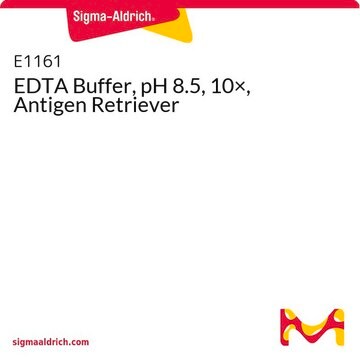EDS
Ethylenediaminetetraacetic acid
anhydrous, BioUltra, ≥99% (titration)
Synonym(s):
(Ethylenedinitrilo)tetraacetic acid, EDTA, Edathamil, Ethylenedinitrilotetraacetic acid
About This Item
Recommended Products
grade
anhydrous
Quality Level
product line
BioUltra
Assay
≥99% (titration)
form
powder
reaction suitability
reagent type: chelator
pH
2.5 (23 °C, 10 g/L)
mp
250 °C (dec.) (lit.)
solubility
water: soluble 0.4 g/L at 20 °C
SMILES string
OC(=O)CN(CCN(CC(O)=O)CC(O)=O)CC(O)=O
InChI
1S/C10H16N2O8/c13-7(14)3-11(4-8(15)16)1-2-12(5-9(17)18)6-10(19)20/h1-6H2,(H,13,14)(H,15,16)(H,17,18)(H,19,20)
InChI key
KCXVZYZYPLLWCC-UHFFFAOYSA-N
Looking for similar products? Visit Product Comparison Guide
General description
Application
- as a medium supplement in embryo culture using synthetic oviduct fluid culture 1 (SOFC1) medium
- in incubation of EpCAM+ cells with fluorescein isothiocyanate (FITC) conjugated antibody for cell sorting analysis
- in pre-treatment of single cell suspension of dendritic cells from spleen for cell sorting with magnetic beads
Signal Word
Warning
Hazard Statements
Precautionary Statements
Hazard Classifications
Eye Irrit. 2
Storage Class Code
11 - Combustible Solids
WGK
WGK 2
Flash Point(F)
Not applicable
Flash Point(C)
Not applicable
Personal Protective Equipment
Choose from one of the most recent versions:
Certificates of Analysis (COA)
Don't see the Right Version?
If you require a particular version, you can look up a specific certificate by the Lot or Batch number.
Already Own This Product?
Find documentation for the products that you have recently purchased in the Document Library.
Customers Also Viewed
Our team of scientists has experience in all areas of research including Life Science, Material Science, Chemical Synthesis, Chromatography, Analytical and many others.
Contact Technical Service




